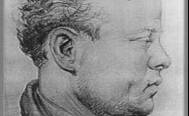Kostas Gliatas–Painter

Kostas Gliatas was born on August 20, 1909, in Chora Messenia and studied at the School of Fine Arts in Athens. Several of his teachers, carriers of the academic style foreign to his own temperament, found little resonance in his artistic profile. He himself, receiving fruitful influences from the great master of iconography, Fotis Kontoglou and his cousin, painter Georgios Gliatas, developed a complex artistic activity.
Kostas Gliatas always felt like a landscape painter, and for this reason, he never stopped representing images from the places of his childhood in his paintings. In his unfinished work "Women reaping wheat", he reveals his influences from the field of Western painting. Gliatas tries to transform even the simplest daily chore into a holy, noble deed in this particular work. This topic was approached by the representative of French realism, Jean-Francois Millet (Jean-Francois Millet), in the middle of the 19th century for the first time. Also, the hagiographies of Kostas Gliatas are independent works. Inspired by Byzantine and folk painting, he crafted the subject, giving it a transcendent dimension mainly achieved with the golden background.
Kostas Gliatas bequeathed his pictorial ensemble (seascapes, idyllic landscapes, ethnographic scenes, still life, hagiographies, portraits) to Chora Messenia, the seat of the Municipality of Nestor (today's Municipality of Pylos-Nestor). Apart from Messenia, his works are in private collections in the Gallery of the School of Fine Arts. At the same time, a male portrait is housed in the Telloglio Foundation of Arts (Aristotle University of Thessaloniki). Kostas Gliatas died in 1994 at the age of 85.



